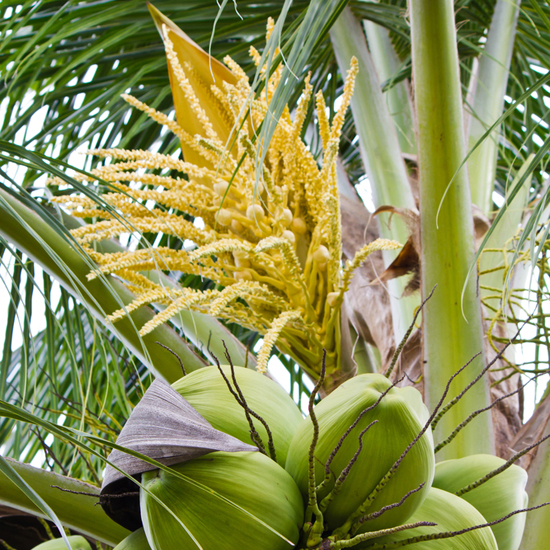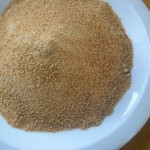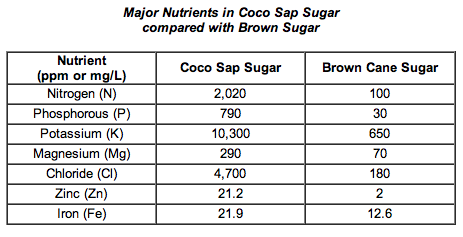
Yellow coconut flowers
Recently a reader emailed me to ask if I had heard of coconut sap. “Coconut sap” is a brilliant name for what I’ve been calling “coconut sugar.” Why do I prefer that term? Because the term, “sugar”, is associated with white refined sugar, which is very bad for you. White refined sugar contributes to all sorts of problems such as heart disease, hypoglycemia, obesity, and diabetes (just to name a few). White refined sugar also feeds the growth of cancer cells as well as yeast or candida.
So, just what is coconut sugar?
 The coconut tree’s stems, which are covered in small flowers, are tapped with hollow bamboo tubes. Once collected, the sap is simmered at low temperatures for about 45 to 90 minutes. And it’s done! The result is a caramel-colored granulated sweetener that can be used just like conventional table sugar. Along with stevia, it’s one of my favorite sugar substitutes. And guess what? Tapping coconut tree sap is very sustainable. Once tapped, the coconut sap flows for the next 20 years. Meanwhile, sugar cane production causes widespread environmental damage (see this report by the World Wildlife Fund).
The coconut tree’s stems, which are covered in small flowers, are tapped with hollow bamboo tubes. Once collected, the sap is simmered at low temperatures for about 45 to 90 minutes. And it’s done! The result is a caramel-colored granulated sweetener that can be used just like conventional table sugar. Along with stevia, it’s one of my favorite sugar substitutes. And guess what? Tapping coconut tree sap is very sustainable. Once tapped, the coconut sap flows for the next 20 years. Meanwhile, sugar cane production causes widespread environmental damage (see this report by the World Wildlife Fund).
Coconut sugar nutrition

Where to find coconut sugar
There are several coconut sugar brands, but the typical grocery store probably won’t carry them. Most health food stores will keep it shelved, but I buy mine from iHerb.com (and you’ll save $5 with your first order using code ROZ388).
References
“Gone coconuts: New sugar or old hype?” from the Michigan State University website
“What is Organic Coconut Sugar” on NaturesBlessings.com
“Coconut Sap ~ Who Knew???” on CoconutSecret.com
Big Tree Farms FAQs on coconut sugar


Andrea says
Hi, I’ve recently been getting into Coconut “sugar”. I think it’s great – sometimes you need some options in sweeteners. I think it’s important to note that the source of the coconut sugar is important. I’ve read about companies who combine it with the white, refined sugar, something we do not want to consume.
My Year Without says
This is very interesting. I have not tried coconut sugar (sap) yet but would love to give it a try, esp. based on the nutrition facts AND the fact that harvesting the sap is sustainable. How cool!
Also, the recipe looks easy and super yummy. I’ll have to give that a whirl, too.
Kelly says
Such a good point, Andrea. I have heard that too, but I have yet to see any of those coconut sugar combos, thankfully.
Thanks My Year Without! Think you may love it too =)
HannahHandpainted says
Love this recipe. I’ll have to try it. I got some coconut sugar for the first time a few weeks ago. The other day I made a caramel corn popcorn recipe using mostly coconut sugar with some agave in place of the normal sugar and corn syrup and it was so good!
Marcy says
can I have your recipe for the caramel corn?
Alexa says
Were you reading my mind?! Dipped into my jar of coconut sugar today and thought “I’ve got to sit down and research this lovely ingredient.” It is so very close in taste and texture to brown sugar! It’s got my thumbs up! Thanks for doing that research for us 🙂 Got great reviews on the coffee cake BTW.
James & Nina says
Do you know any place local to get Coconut Sugar? We’ve been looking but have not found it anywhere in the area.
Kelly says
Thanks Hannah!
James, I get mine from Azure Standard co-op. We pick it up once a month. There’s no minimum amount you have to spend if you want to join. We were picking up near Loveland, but it we may be picking up in Longmont starting in mid May. I think Whole Foods in Boulder has it too. I saw it once at the one by the library, on Arapahoe.
Kelly says
Thanks Lexi!
Brandon says
I’ve been wondering if I should purchase some coconut “sap”, and this post cemented the idea. It’s fairly inexpensive, I suppose, so I might as well. It will be a good sweetener that I can blend in with my other favorites–xylitol, stevia and sometimes raw honey (also Sucanat, but at very low quantities.
atxglutenfree says
Great information on coconut sap sugar. I never knew how it was made. That is good that they do not heat it above a certain temperature and keep it relatively low. The ice cream looks delicious 🙂
gfe--gluten free easily says
This post is very helpful, Kelly. I’m ordering coconut sugar the next time I place an online order. I already have all the other ingredients to make this recipe, so I’m getting closer than when you posted it the first time. 😉
Thanks, Kelly!
Shirley
Amy @ Simply Sugar and Gluten Free says
I agree with everyone else…this is a great post. I’ve been using coconut ‘sap’ and love it. It works beautifully in so many dishes. I think the taste is much like brown sugar but it’s not overly sweet.
PS – saw the tweet about your upcoming book. Congrats!
GF Gidget says
I have everything, but the Coconut Sugar. Can I use liquid stevia instead?
Kelly says
Thanks guys!
GF Gidget, I don’t know. That may be fine =)
Sandy says
Oh.My.Word. I can’t believe this is breakfast!! I actually bought coconut (palm) “sugar” at my local grocery store. Thank you for the valuable information as well as the marvelous recipes!
Seattle Mom says
Just wondering if the Chocolate Pudding mixture can be put into an ice cream maker? Has anyone tried that? AND, do you really blend it for 10 MINUTES after you take it out of the fridge? My blender would probably keel over if it had to work that long. LOL Might be time for a new blender. We LOVE LOVE LOVE your Spunky Coconut Cookbook and can’t wait for the next one!
Kelly says
Thank you, Sandy!
Seattle Mom, Yes, I have tried that, and so have others—excellent ice cream. And thanks for catching my typo! I changed it—Meant to say, “put in the ice cream machine for 10 minutes…” xoxo
Dawn says
Kelly I am so Very glad that you addressed the coconut sugar because I couldn’t find it or anyone that had heard of it out here in the Indiana sticks. I found an organic palm sugar on line at the nutsonline website, but they don’t call it coconut sap, but it is from the coconut palm tree. I will eventually have all the items for these wonderful recipes-thanks again and again–Dawn
Beth says
Thanks for the recipe. It tasted good. I had never tried Hemp or Chia seeds. I will make it again. I couldn’t find coconut sugar. I had some date sugar that I needed to use up so I substituted that instead.
Carrie says
This looks SO good Kelly! I’ve really been enjoying your blog recently Kelly! I’m a long time lurker and I appreciate all the wonderful raw & vegan inspired recipes you share! Thank you!!
hepcatkitn says
Thank you so much for your amazing blog! I made this yesterday and it is tasty, but mine never “set up”. I substituted flax seeds for the hemp and chia would that cause it?
Kelly says
That is definitely the cause. It should work if you try it again with chia 🙂
Anonymous says
Hi! Thanks for your lovely blog and recipes. I tried the pudding recipe twice, and although it tasted just like chocolate pudding — it never set properly. Any ideas why not? It was still good as a smoothie mixed with banana and ice.
Thanks!
Kelly says
I don’t know why it didn’t firm up at all. I would add a couple tablespoons of coconut flour or more chia, and see if that helps.
Kelly says
I just had a thought! Did you use canned coconut milk?
Lisa says
Kelly,
I can’t get coconut sugar ;locally. Do you think this would work if I used agave?
Kelly says
Lisa, I don’t think it would firm up with agave. How about soaked pitted dates?
Susanne says
hi kelly! quick question: what is “vanilla extract meal”? is it the same as the liquid vanilla extract, or was it a typo? i tried to google it and came up with a lot of fishing bait websites. (?) lol
thanks for sharing all your amazing goodies with us! i just found your blog and i’m so excited. can’t wait to try everything!
Jennifer Gehman says
Question: If you are allergic to coconut…would you react negatively to the sugar? Appreciate your wisdom!
Allergic to odd stuff says
I myself am not allergic to actual coconut (milk/cream/water/flesh) but I am seriously allergic to palm oil (get infected hives and migraines). My son is seven years old and has had serious allergies to coconut sap in a soy sauce replacement from Coconut Secret. His face gets extremely scary pustules. He can eat coconut sugar. Go figure. Just pay attention to your own reaction to any product, and beware the possibility of an ever worsening allergy that could become anaphylactic.
Tasty Eats At Home says
Yum! This looks so good. I love coconut sap – it’s so flavorful. This pudding reminds me of raw avocado pudding, only less umm…green! LOL
paul says
It’s definitely good to know more about coconut sugar. Thanks a lot for sharing that information.
Vitamins Canada
Katelyn says
this looks absolutely fabulous. might have to buy a new keyboard- drooling all over it!
Teresa says
I saw a link discussing some problems with the sustainability of coconut sugar here: http://www.tropicaltraditions.com/coconut_palm_sugar.htm
Do you know if it’s a valid problem?
Thanks!
Andrew says
Coconut sugar is sustainable in that a farmer can tap a tree indefinitely. What Tropical Traditions doesn’t like is that this new demand for coconut sugar competes with a tree’s traditional use for producing coconut milk/oil/flour. If there is such a high demand for all these coconut products, then I don’t understand why this can’t be met by new coconut plantations: coconuts are grown all over Asia and S. America. I think TT’s concern is that their local growers are moving over to sugar production, which makes their particular supply of coconuts more difficult.
Anonymous says
A lot of attention is given to glycemic index, but except for people with blood sugar/insulin disorders, I’m not sure it’s a very relevant measure. At least for athletic performance, higher glycemic index is usually a short term benefit.
I think what “ose” coconut sap is important. Sucrose (cane & beet sugar) and fructose (fruit & refined corn sugar) are more of the culprits, because what’s not used immediately by the body for fuel is stored in adipose tissue (not good) and in the liver (bad). Glucose however is stored in the muscles (better or good).
Coconut sap is 85 to 89% sucrose.
Tom
Anonymous says
…Looks delicious! Thank you for the article on coconut sap. We replace the cacoa with carob powder…. Worth checking into it. 🙂
Anonymous says
I just got introduced to your blog and love it! Thanks for doing it.
I haven’t tried coconut sugar yet but the limited research I have done on it claims it is not “sustainable” so I haven’t bought any yet. Please check out this website:
http://www.tropicaltraditions.com/coconut_palm_sugar.htm
Thanks!
Josie says
I just made this and it is AMAZING.. So delicious. This was my first time using coconut sugar. Thanks for the recipe!!
S. says
Can hemp seed meal be replaced with flax seed meal?
Savannah Clendinnen says
Is coconut sugar safe for diabetic people? I would love to try that recipe because of the berries.
Steven Fisher says
Wow thank you for this information! Truly, coconut has so many uses and do offer a lot of health benefits.
Gabriel Russell says
Coconut sugar making is most common in tropical countries. This kind of sugar has a low-GI of 35. An indication of how quickly a specified amount of food will cause a rise in blood sugar level is Glycemic Index or GI means. Sugar substitute or artificial sweeteners like aspartame on the other hand has much more lower GI or sometimes no GI rating at all.
Anonymous says
Great article but it’s not sap- I spent time this weekend with a coconut sugar manufacturer from Bali and he dispelled the common myth that has circulated through internet blogs that it is the sap- similar to maple syrup. It is not- it is the nectar of the flowers.
Beverly Alfeld says
There are two types of sugar from coconuts. One is from tapping from the flower and the other from the stems. Coco-sap sugar is from the flowers. I was just in Thailand and watched it being made. The process is a little more complicated than explained here. See upcoming issue of Fruit Gardener magazine for an article on the subject.
Kelly says
Thanks for the info! 🙂